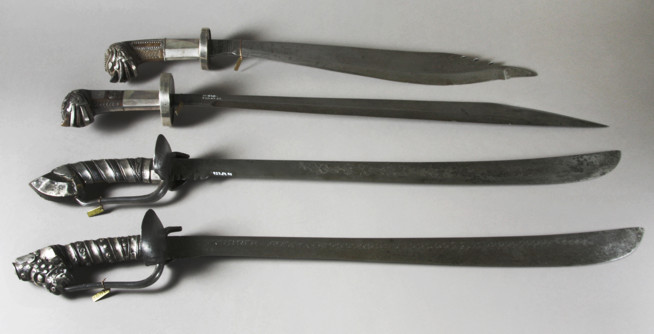Ifugao hinalung- short double sided often leaf shaped bolo with a point. No crossguard and hand is usually straight and covered by fiber. The sword actually doubles as a spear point (the handle is usually hollow). Scabbard is usually open faced (design that is not only typical in many Northern Luzon tribes but also in many Formosan) they call hikot.
Hollow handle (where spear shaft goes in)
Variations
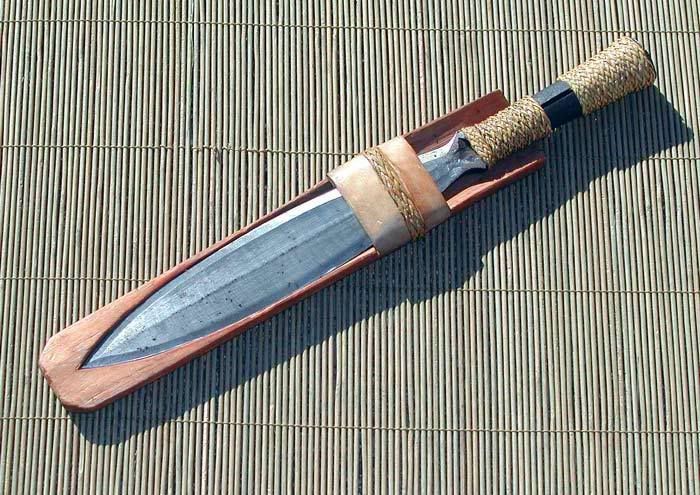

Formosan open scabbard design (Atayal or Bunun)...note the shape of their handle (and some of them are also hollow)
http://www.ashokaarts.com/shop/rare-...e-atayul-tribe
Truku or Atayal
http://www.functionalselfdefense.org...l-truku-knife/
Archaeology [Solved] Deadly and Beautiful Filipino Weapons
Online?
Different pommel design
Tenegre/sanduko (the blade/iron supposedly traded from lowlanders, but the highlanders shape the handle) type of Panay sword with pommel design of deities/mythical creatures and animals (usually shown as grinning/open mouth with fangs).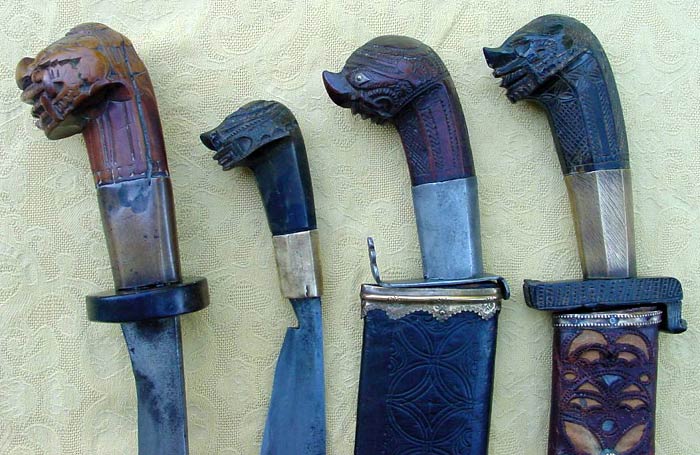
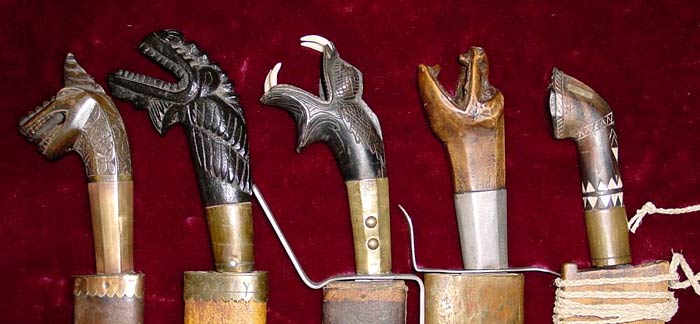
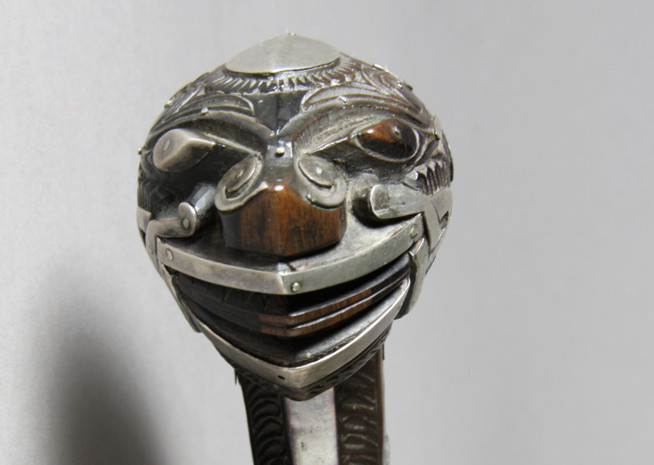
Kakatua (cockatoo) design pommels = s-shaped pommels, imitating the short beak and the head crest of cockatoos.
Junggayan design popular in Mindanao (specifically Moro) blades...I think it's also seen in Malay swords. Used in many different blades. Usually made out of wood, iron, silver or ivory (most times they actually used dugong).
Barong (Tausug)- usually made of banati wood, but this one I think is made out of ebony (Philippine kamagong)
Also a barong made of wood (sword owned by Abu Sayaff commander)
Ivory
Kris (Moro) wood + metal
[QUOTE=MaharlikaTimawa;414100]Notice how most of the good weapons from the Philippines are all Moro made
The classical Ilongo Ginunting that made the Japanese piss their pants in Negros after getting chopped to pieces by them is not Moro. It is so effective that even Philippine marines today still uses a variant of it in the form of FMA Pekiti Tersia Kali.
A Military Ginunting wielded
[IMG]  [/IMG]
[/IMG]
[IMG]  ?ig_cache_key=MTEwNzIxNzU4NzE0ODM3ODY1NQ%3D%3D.2[/IMG]
?ig_cache_key=MTEwNzIxNzU4NzE0ODM3ODY1NQ%3D%3D.2[/IMG]
The Visayan Binangon that is a Bolo packed with the power of an Axe and is a classical handsome blade that was the forerunner to the original Ginuntings, descended from Visayan farming tools. These bad boys were also used to chop down ambushed Japanese in Negros. A Binangon
[IMG] http://www.vikingsword.com/vb/attachment.php?attachmentid=124071&stc=1 [/IMG]
The classical favorite Pinuti of the Visayas is not Moro and is also used by the Philippine marines using the Pekiti Tersia Kalia FMA style.
[IMG] http://www.vikingsword.com/vb/attachment.php?attachmentid=69908&stc=1 [/IMG]
Below here is a single edged, chopping saber. A Luzon/Tagalog modification of a Burmese Dha that looks like a chopping version of a Katana and is not Moro. Moros could only hope to have something like this. [B]THIS ANTIQUE LUZON DHA HAS A SCABBARD WITH BAYBAYIN INSCRIPTIONS ON IT. Don't know what it reads.[/B]
[IMG] [/IMG]
the Lugod/Saranggot/Lihok knife is a relatively indigenous and slightly modified historical version of the Indonesian Karambit from the Ilonggos as well. Its design is deviated enough from the original to the point that you need to use a different technique to use it and is being used in Kali and many FMA styles.
[IMG]  [/IMG]
[/IMG]
the Balisong butterfly knife, a classical Filipino knife is not Moro.
[IMG] 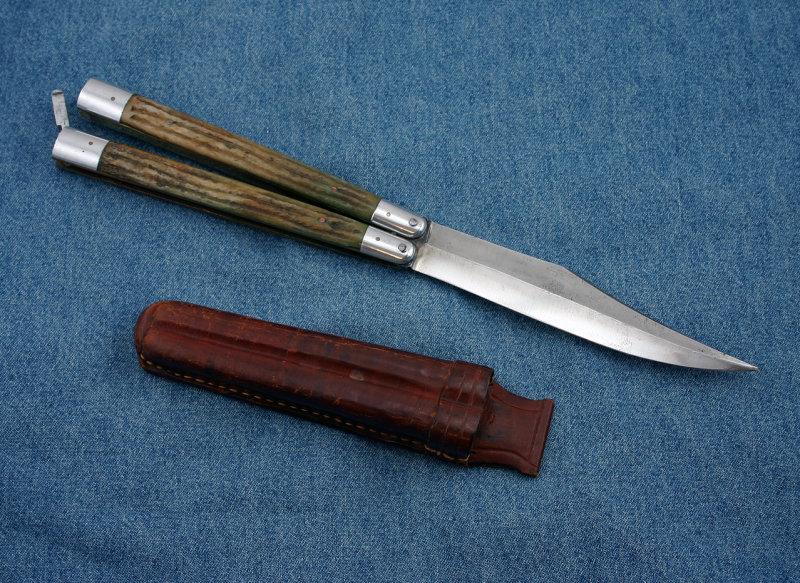 [/IMG]
[/IMG]
Antique Igorot axes on the right.
[IMG]  [/IMG]
[/IMG]
Binaroy, a northern Luzon axe, very functioning and excellent for chopping is vaguely similar to a smaller version of a Panabas. Kinda kind-of-ish similar to a Panabas.
[IMG]  [/IMG]
[/IMG]
The only totally distinct Moro weapons to my liking in my mind that has no serious effect-wise counterpart in the rest of the Philippines would be the Kris and the Panabas which the latter is an enlarged Indonesian Kris.
To which, even then, every weapon that Mindanaoese have, the Visayans and Luzonese already have something just as effective for the same job. You don't need a Moro Panabas if you have Bingangons and other similar heavy blades capable of chopping wood that's been used to cut sugar cane for centuries, you don't need heavy Kampilans when your daily need is close quarter combat and utility use for these Islands and when what you seriously need is a bolo in close quarters combat akin to the environment. You don't need Kris when you have countless weapons to do similar cutting and stabbing for you such as Barongs, Bolos, Pinuti, Dha, Talibong, Ginuntungs and etc. that are in some ways better in portability that are just as good at doing their job as a Kris. Where did you get this idea that only Moros have most of the good blades?
All these blades are recognized by enthusiasts and professionals as high functioning, effective melee weapons by Filipino MAs and foreigner ethnographic sword nerds or are iconic classical blades and part of the proud Philippine blade culture and are far from being Moro. Moro blades are very awesome on their own, very well forged classics, but they're not the only ingenious smiths in these Islands, we need to stop putting Moros on the pedestal. I have to respectfully but strongly disagree with you that most effectively great Filipino blades are Moro. Far from true.
Another perspective snap-shot of a Filipino dha sword with its own scabbard inscripted with Baybayin.
Click here to view the original image of 2048x1536px.
Sticking to topic, some pretty sick, battle-used antique blades from Iloilo museum.
Top: Traditional Ginunting, with a cool hilt.
Middle and Bottom: Pair of albeit rusty Talibongs in good shape.
Very good detail on the handles too!
I love the modern Ginunting, but the traditional ones looks pretty sick on its own too!
Anyway, I'm not exactly sure what these are, but the first two blades are obviously based on Iloilo based blades again.
And some more antique, well constructed Iloilo blades.
Another rare, antique Iloilo Binangon/classical Ginunting.
It's crazy that these blades are still in good shape even after several decades.
This blade here below looks like a Panabas from Mindanao, but believe it or not, sources say it is actually from North Eastern Luzon. The handle and scabbard looks really mundane compared to a Moro Panabas.
[IMG] http://www.vikingsword.com/vb/attachment.php?attachmentid=34684&stc=1 [/IMG]
19th century batangas bolo knife. It is a heft/heavy knife, blade is made of laminated steel. Max. blade thickness 7 mm
Interesting random Philippine-American war era Moro-Bolo. Although sources say it is of Moro origin (so does the hilt and handle indicate), the blade looks strangely almost if not exactly like some old traditional Visayan blades for some weird reason save for what I think, that this Moro blade looks thinner and doesn't seem as hefty/heavy compared to some of the more classical Iloilo choppers.
Random Luzonese/Visayan/Mindonese swords cluttered together.
-
English Words That Came From The Philippines
1 year ago
-
The New Captain America is a Filipina!
3 years ago
-
Filipino Freemasons in the government
3 years ago
-
Filipina Olivia Rodrigo Smashes Records With 3 Singles in Top 10 of Billboard’s Hot 100 Chart
3 years ago
-
Filipino ancient God MYTHOLOGY
4 years ago


